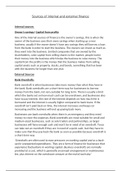Sources of internal and external finance
Internal sources
Owner’s savings/ Capital from profits
One of the internal sources of finance is the owner’s savings, this is when the
owner of the business uses their owns savings when starting up a new
business, usually if the owner doesn’t have any savings they will borrow a loan
from the bank in order to start the business. The owners can invest as much as
they want into the business. Limited companies that are owned by the
shareholders, raise capital from selling shares to the market, people invest
their money into the business which helps the business to raise money. The
capital from the profits is the money that the business makes from selling
capital assets such as property, stocks, and bonds, something that has been
with the business for longer than one year.
External Sources
Bank Overdrafts
Bank overdraft is when businesses take more money than what they have in
the bank. Bank overdrafts are a short-term way for businesses to borrow
money from the bank, not very suitable for long term. There is usually a limit
which the banks set on how much cash can be overdrawn, and businesses also
have to pay interest, the rate of the interest depends on how much the is
borrowed and the interest is usually higher compared to bank loans. If the
overdraft isn’t paid back on time, the interest increases and keeps on
increasing and the business will end up paying back more.
Businesses use bank overdrafts when there is an emergency and they need
money to cover the expenses. Bank overdrafts are most suitable for small and
medium-sized businesses, such as sole traders and partnerships, as larger
businesses will have enough cash and won’t be in need of an overdraft. Tesco
can take out an overdraft if they are in need of a quick cash, but they have to
make sure that they pay back the bank as soon as possible because overdraft is
a short-term way.
‘Overdrafts are often used to ease pressures on working capital and as a back-
up for unexpected expenditures. They are a form of finance for businesses that
experience fluctuations in working capital. Business overdrafts are normally
provided at a cost, which is generally an annual arrangement or maintenance
fee, plus interest on the overdrawn amount at the end of each day’





